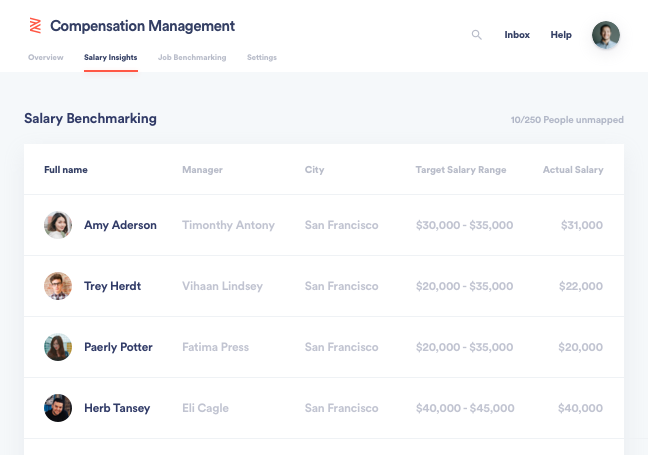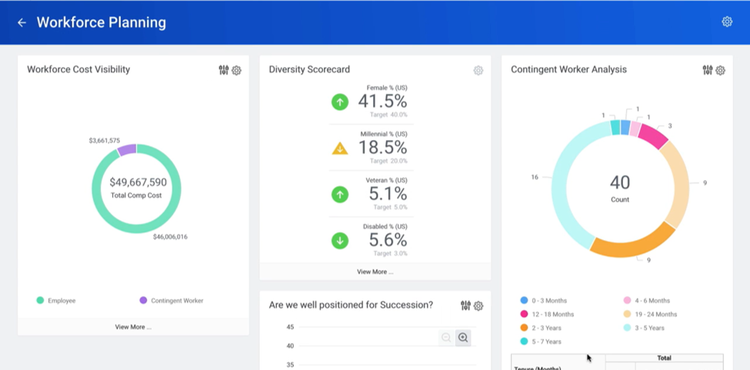HR hasn’t traditionally been the most data-driven department. Employees are individuals, not numbers, so what value could you get from analyzing data about people?
Many workers view attempts to collect data about them as showing a lack of trust, being a bit creepy, or attempts to spy on them.
However, an HR department can use its “people data” to not only improve the working environment for employees, but also save the company time and money -- as well as plan better for future workforce needs.
Overview: What are workforce analytics?
Workforce analytics -- otherwise known as human resource analytics or employment analytics -- is a way of tracking and measuring your employees’ performances, whether on a department level, per job role, or per individual employee.
By collecting data on your employees, you can make better decisions in managing your workforce. You can also improve the work environment and make life easier for all your staff, both in the HR department and at the company as a whole.
The HR metrics you can track include performance and talent management information, demographic data, and procedures and processes.
Benefits of tracking your workforce analytics
Employee analytics can be beneficial not just to the HR department, but also to the company as a whole.
Make better decisions
In the past, a lot of HR decisions have been based on gut feeling or one person’s previous experience. While this information is useful, supplementing it with data and analysis can help HR professionals make more informed decisions.
Instead of basing employee retention efforts on casual chats with employees over a coffee, you can use past indicators and specific data to create a more solid basis for making decisions.
For example, instead of making changes based on one exit interview with an employee who is leaving, you can collect data from all of these interviews to understand what makes people quit.
Save time and money
Workforce planning and analytics can help you recruit the right people, retain your top staff, and ensure a smooth transition when any of your valuable workers leave by analyzing data not just on an individual basis, but across a group of different people.
This not only provides a much more complete picture of what is really happening, it also saves you a lot of time and money in guesswork. The data does the work for you.
The bottom line? Workforce analytics can improve your bottom line by minimizing disruptions, maximizing productivity, and ultimately, saving your business money.
Boost morale
If used in the right way, and by focusing on the right HR reporting metrics, workforce analytics can show your employees you care.
This doesn’t mean saying to an employee, “Our data shows that Jane Doe is more productive than you. Up your game, or you’re out.”
Instead, you can use the data to ensure that there are adequate staffing levels, so no employee feels like they’re overworked. Or you can use your data to proactively give workers pay raises so they are in line with (or above) the industry average.
You can also make improvements based on the feedback they give you. For example, you can change the departmental meeting from weekly to bi-weekly, or only invite the relevant workers rather than everyone in the department.
These actions will show your employees that you want to create the best possible workplace for them.
Ways you can use your workforce analytics in your business
You can use workforce analytics to drive improvements in almost any area of your business, whether it be recruiting the talent of the future, ensuring you have adequate staffing levels, or keeping your employees happy so you can retain your star workers.
Succession planning
Your employees aren’t going to stick around forever, which is why you should always be thinking at least one step ahead. What will we do when our top-performing salesperson moves on? How will we structure the team if two of our top data managers leave at once?
Workforce analytics can help you with succession planning, which means identifying people who can step up and fill the roles left vacant by departing talent.
By doing this, you can minimize disruptions and downtime and save time having to scout around for external talent.
How to implement succession planning:
One of the most important aspects of succession planning is to be constantly working on plans for when your top employees leave. Here’s how to put the strategies in place to plan for the future.
- Invest in training: Unless you provide ongoing training opportunities, it’s unlikely anyone will be able to step up and fill a more senior role immediately. Don’t see training as a cost center; instead, think of it as a long-term strategy to get the most out of your current workforce.
- Carry out continuous appraisals: Traditionally, companies only carried out appraisals once a year. Now, the trend has moved toward reviewing performances and giving and receiving feedback on a regular basis -- sometimes as often as once a week. This way, you can quickly spot the top talent that you should be training to (eventually) take on more senior roles.
Employee retention
By the time an employee tells you they are leaving, it’s normally too late to get them to stay. That’s why you need to be alert to signs that people are unhappy before they hand in their notice. There’s a lot of data you can collect that can help you understand where you may be going wrong and how you can improve.
How to improve employee retention:
You need to be proactive if you want to improve employee retention. Here are the strategies you need to use to keep your employees happy and minimize the chances they’ll want to leave.
- Review compensation regularly: Money does matter. Make sure your employees are receiving fair pay for their work by checking industry and regional benchmarks. Workforce analytics software such as Zenefits lets you compare the salaries of all of your employees against these benchmarks to see if you’re falling short.
- Ask employees how they feel: Send out surveys regularly with a couple of short questions to help you understand any issues you need to work on or things that you’re doing well and could expand on.
- Prioritize exit interviews: You can get great insight from people who are leaving. Find out if there’s anything you could have done to make them stay, and then use that data to make changes that could lead to better retention.

Zenefits lets you compare compensation data to industry and location benchmarks. Image source: Author
Recruitment
There are a number of different ways you can use workforce analytics to improve your recruitment processes. This includes using predictive analytics to anticipate what new roles you’ll need to recruit for as your company grows or expands into new areas, or working out what skills to look for in new hires based on the talents of your current workforce.
Other workplace analytics examples include using data to improve the way you recruit, streamlining processes, and speeding up time to hire.
How to use workforce analytics to recruit staff:
Having access to data from across the business is crucial if you want to be able to plan ahead. Here’s how you can use that data to improve recruitment processes.
- Collect feedback: If you want to recruit people in a more efficient way, ask your new hires to tell you what they think of your hiring process. You can then use that data to make improvements for future candidates.
- Centralize your data: You need to get an overview of overall business performance and strategic plans if you want to be able to draw up recruitment plans in advance to match your company’s needs. To do this, you need access to data from different business functions. If you want to achieve this, you either need an all-in-one HR solution like Workday, which includes business performance data, or you need HR software that integrates with other business tools, such as Zenefits.

Workday provides you with data on overall company performance. Image source: Author
Shift planning
Carrying out workforce analysis can help you plan the optimal staffing levels for your company so you can implement smooth shift planning processes. You may need a different number of staff at different times of the day, month, or year.
This could be due to the nature of the work carried out on a shift that requires certain skills (such as stock management) or the seasonality of certain industries.
Workloads and requirements change, so you need to be on the ball when it comes to planning your shifts to ensure you have the right staffing levels. Too many staff, and your business costs will suffer; too few staff, and customer satisfaction will suffer.
How to optimize shift planning:
Leveraging your data can help you better understand your needs, make sure you have the right skills on hand when they are most needed, and avoid understaffing or overstaffing. Here are the strategies you need to succeed.
- Implement an absence management process: One of the biggest barriers to successful shift planning is not properly managing employees’ absences -- whether it’s planned or unplanned leave. Having a set of rules in place stops employees taking leave at the worst time of the year -- such as Black Friday for retailers -- and it means you can plan your staffing levels around these absences.
- Understand employees’ skill sets: It’s important to collect data on what skills employees possess so you can make sure the right people are on the right shifts to cover the work that needs to be carried out at that time. Ensure that this data is integrated with your shift management system so you can properly plan for the upcoming weeks and months.
- Have contingency plans in place: Use your data to understand when you are most likely to have a spate of illnesses (for example, people always seem to come down with the flu in January) or the most vacation requests (for example, during school holidays). Plan ahead so that you can be sure you’ll have cover for when more people are unavailable than usual.
The power of people data
You don’t have to be a data scientist to work as an HR professional, but it’s key to recognize the importance of the information you collect about your employees.
In the past, companies often collected data on people solely to ensure they were meeting targets -- and perhaps to reprimand them if they were off the mark.
However, more and more companies are waking up to the fact that people are the most important asset in any business, and when your employees are happy, your whole organization performs better.
Collecting, analyzing, and gaining insight from employee data can have a transformative effect on not only company performance, but the workforce as a whole.
Our Small Business Expert
We're firm believers in the Golden Rule, which is why editorial opinions are ours alone and have not been previously reviewed, approved, or endorsed by included advertisers. The Ascent does not cover all offers on the market. Editorial content from The Ascent is separate from The Motley Fool editorial content and is created by a different analyst team.